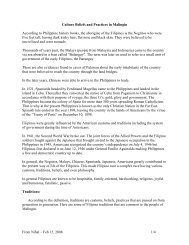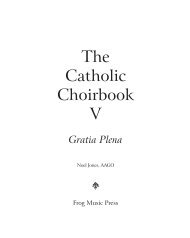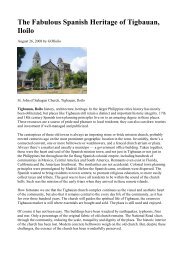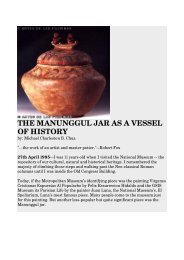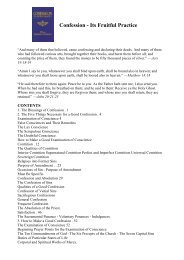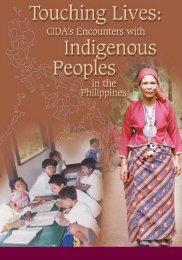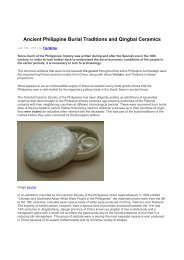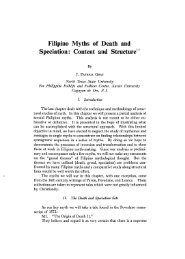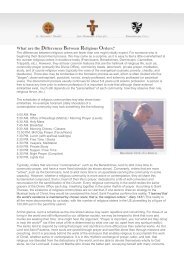(Lovely Ilocana) and Kalapati (Dove). - Philippine Culture
(Lovely Ilocana) and Kalapati (Dove). - Philippine Culture
(Lovely Ilocana) and Kalapati (Dove). - Philippine Culture
You also want an ePaper? Increase the reach of your titles
YUMPU automatically turns print PDFs into web optimized ePapers that Google loves.
Christmas. The sound of these b<strong>and</strong>s is similar to that of the MexicanmariachiTHE CABUGAO INSTITUTE MARCHING BAND. The b<strong>and</strong> played forschool, military, <strong>and</strong> civic parades.
MARCHING BAND
<strong>and</strong>s, <strong>and</strong> differs only in the absence of brass wind instruments, particularlytrumpets.In the 1920’s <strong>and</strong> 1930’s, Cabugueño immigrants in the United States <strong>and</strong>Hawaii began sending home to relatives all kinds of brass <strong>and</strong> other windinstruments as well as stock arrangements of popular American music. Thiscorrespondence enabled the formation of dance b<strong>and</strong>s consisting mostly ofthetown’s musically inclined schoolteachers who could read the charts. Theyplayed for dances in all of the town’s social events. In the 1930’s <strong>and</strong> 1940’s, thethree most popular b<strong>and</strong>s that played the town fiesta circuit were the Remy’sSwing B<strong>and</strong> from Vigan, <strong>and</strong> the Laoag Stompers <strong>and</strong> the Ambassadors fromIlocos Norte. They played the music of Count Basie, Woody Herman, BennyGoodman, Harry James, Glenn Miller, the Dorsey brothers, <strong>and</strong> other swingb<strong>and</strong>s. The avant garde stompers from Pangasinan played a lot of StanKenton’s arrangements. Teacher Mariano Somera was a saxophonist <strong>and</strong>leader of the local b<strong>and</strong> called “BARCIS” (acronym for Barangobong, Cabugao,Ilocos Sur).With increased availability of brass <strong>and</strong> reed instruments, more b<strong>and</strong>swere formed for special events such as parades, funerals, religious processions,<strong>and</strong> dianas (musical concerts of “wake-up calls” at sunrise of religious holy days).These b<strong>and</strong>s consisted mostly of older men playing martial <strong>and</strong> funeral music.
Interestingly, they played slow <strong>and</strong> somber funeral dirges for the funerals ofadults, but if the deceased was a child, they played jubilant Sousa marches allthe way to the cemetery. The latter was supposedly a happy celebration of aninnocent child’s assured place in heaven. From the 1920’s to the 1950’s, twocompeting b<strong>and</strong>s of this kind were the “Midis” (lakay or old man “Midis”) <strong>and</strong> the“Pulikin” b<strong>and</strong>s. The loud beating of the bass drum that could be heard all overtown was the signal either b<strong>and</strong> gave to its members to assemble for a gig—usually a funeral. The Cabugao Institute also had a marching b<strong>and</strong> for military<strong>and</strong> school parades. The town always had a good number of talented musicians.Pre-colonial music is not completely lost, particularly among the people inthe barrios. To this day, the Tingguians have music sung in the pentatonic scalesimilar to that of Chinese music. The scale consists of five successive tonesexcept for the third <strong>and</strong> fourth notes, which are one-<strong>and</strong>-a-half tones apart.Thus, if the key note is F sharp, the pentatonic scale on the piano keyboardconsists of only the black keys. The popular piano piece “Chopsticks” is played inthis key. The most widely known example of a Tingguian song in the pentatonicscale is “Salidummay.”The first keyboard instrument of the town was the old “harmonium” (pedalpumporgan) of the church, which was imported from Europe sometime in thenineteenth century or earlier. In the nineteen-twenties, Mr. Basilio Inofinada fromSinait was the church organist, <strong>and</strong> the male choir singers or cantores came fromcacantorisan (southern part of town named after the resident cantores). In thenineteen-thirties, Maestra “Itong” Pe Benito took over as organist, <strong>and</strong> the choir
consisted entirely of women: the Sison sisters (Cianing, Kiday, <strong>and</strong> Corring) <strong>and</strong>a few others. Mr. Inofinada’s younger brother, Eufemio, who studied violin at theUniversity of the <strong>Philippine</strong>s Conservatory of Music, <strong>and</strong> Miss Eden Pacis werethe only two piano teachers giving private lessons before <strong>and</strong> after theSecondWorld War. During that period, there were pianos in the homes of Miss Pacis,the Sisons (Rosario Sison Pilar, Salustiano, Pacifico, <strong>and</strong> Dr. Teodoro), BrunaSevilleja, Robustiano Bernardez, Supervisor of Elementary Schools JulianSomera, Pina Savellano, Dr. Luz Apostol, the Gallardos, <strong>and</strong> the Panos. Mrs.Tomasa Serrano Pano inherited the oldest piano of Cabugao from hergr<strong>and</strong>father Don Le<strong>and</strong>ro Serrano, who had imported the instrument from Europein the nineteenth century.Don Le<strong>and</strong>ro’s great-gr<strong>and</strong>daughter, LutgardaSerrano Sison (Cortes), was the first music (piano) teacher who graduated froma music conservatory, the Holy Ghost (now Holy Spirit) College, in 1952.Long before the Spaniards introduced European string instruments (guitar<strong>and</strong> violin) <strong>and</strong> the harmonium, the natives had their drums, gongs, bells,bamboo flutes, <strong>and</strong> kutibeng (stringed bamboo). The kutibeng was a bamboosegment plucked like a guitar. It had built-in strings made by separating str<strong>and</strong>sor slivers of the tough outermost layer or skin of the bamboo, raised <strong>and</strong>stretched over a “nut” at one end <strong>and</strong> a “bridge” at the other end. As in otherprimitive cultures, the music <strong>and</strong> dance were originally performed as rituals ofreligious worship.
The colonialists introduced Spanish <strong>and</strong> other recreational dances <strong>and</strong>music from Europe: jota, f<strong>and</strong>ango, polka, mazurka, gavotte, valse, rigodon dehonor, <strong>and</strong> many more. In the twentieth century, the norte-americanos (NorthAmericans) brought their pop music <strong>and</strong> ballroom dances. A few earlierimmigrants to the United States returned home with the Charleston, fox trot, thebig apple, <strong>and</strong> other dance steps of the roaring twenties. Hollywood soundmovies in the thirties continued to update dancers on the jitterbug, Lindy(honoring Charles Lindbergh), boogie-woogie, swing, <strong>and</strong> Latin-Americanrhythms. Commonwealth President Quezon was the country’s foremost tangoaficionado. His spectator shoes for tango dancing became known as “tango”shoes.The Americanization process did not completely bury Cabugao’s nativeculture. Ilocano folksongs were not forgotten. Serenaders continued to sing “oldst<strong>and</strong>ards” such as No Duaduaem Pay, Pamulinawen, <strong>and</strong> Bannatiran, alongwith “My Funny Valentine.” The children continued to learn “Duron-duron kapetkapet,aramid daguiti babbaket, aglalo no ti suming-et” <strong>and</strong> other naughty songslike “Natay ni donggialen, nagagara ti ar-arem . . .” Many homes had Victrolaphonographs playing Brunswick recordings of Procopio Borromeo’s Ilocanosongs as much as Rudy Vallee’s songs <strong>and</strong> American ragtime. Until the SecondWorld War, only the homes of Dr. Teodoro Sison <strong>and</strong> Judge Andres Cabanoshad shortwave radios playing current “song hits”.With the advent of the radio, recorded music, <strong>and</strong> electronically amplifiedrecord players after the war came the so-called “jam sessions,” which were
weekend gatherings of young folks for the purpose of dancing. Live b<strong>and</strong>scontinued to play for larger community affairs. Ballroom dances were often heldfor fundraising through the sale of admission tickets <strong>and</strong> ballots for beauty queencontests. Cabugueños also had a unique traditional fundraiser called the “boxsocial.” The opportunity to have a special dance with a beautiful young lass wasgiven to the highest bidder—a “show-off” but a generous donor to a worthycause.RIGODON DE HONOR, Spanish version of the French quadrille <strong>and</strong> adoptedas the traditional opener of Filipino ballroom dances. The dancers march to atwo-step (2/4) music tempo, the gentlemen curtsy to their partners, <strong>and</strong> thecouples exchange partners. The gr<strong>and</strong> finale is a cadena (chain), in which theladies circle one way <strong>and</strong> interweave with a circle formed by the gentlemenmarching in the opposite direction. Among the participants in the photograph areCommission on Elections chairman, Sixto B. Brillantes, <strong>and</strong> his wife, AzucenaOliver Serrano.
RIGODON DE HONOR
An ILOCANO POEM jointly composed by Judge <strong>and</strong> Mrs. Andres B. Cabanos<strong>and</strong> dedicated to Mr. <strong>and</strong> Mrs. Salustiano S. Sison upon the death of the lattercouple’s sixteen-year-old daughter, Charito.
Over three centuries of Spanish influence has left an indelible mark onFilipino music. The old European <strong>and</strong> native folk dances, however, have becometheatrical pieces staged only for tourists <strong>and</strong> other visitors on special occasions.POETRYThe two most celebrated Ilocano poets, respectively of the late nineteenth<strong>and</strong> early twentieth centuries, were Leona Florentino (a cousin of Jose Rizal) <strong>and</strong>Leon Pichay. Cabugao had among its poets Judge Andres Cabanos, SalustianoSison, <strong>and</strong> Eduardo Cobangbang. Catalino Cobangbang was a young talentedpoet who died in 1921 while attending Stanford University. During his studentdays at the University of the <strong>Philippine</strong>s, Crescencio S. Azcueta regularlycontributed his poems to the campus publication, The <strong>Philippine</strong> Collegian. Thetown’s most famous poet thus far has been Jose Maria Canlas Sison. Afterspending eight years <strong>and</strong> four months as a political prisoner in Fort Bonifacio, hisbook of poems in English, entitled Prison <strong>and</strong> Beyond, was published <strong>and</strong>received the Southeast Asia WRITE Award in 1986. The daniw or Ilocano poemsometimes was composed extemporaneously <strong>and</strong> recited in a repetitivemelodious singsong intonation called the dallot. At a funeral wake, the mosttheatrical of all poets was the professional mourner, usually an elderly woman.When engaged for her services, she would prepare for her “performance” bylearning about the highlights of the life of the departed one <strong>and</strong> the survivingfamily members. More than merely eulogizing, she would cover herself with a
manton de manila (a big black veil), <strong>and</strong>, between sobs, would beginwailingpoetic expressions of sorrow on behalf of the family. The melancholic singsongrecitation of the dung-aw never failed to move bereaved family members <strong>and</strong>friends to tears. The crying induced by the dung-awwent on sometimes forhours <strong>and</strong> seemed to be consoling or even physically therapeutic.DRAMA AND THEATERThe church became the first theater when Padre Hieronimo Perez’ “UnaGran Comedia de la Toma del Pueblo de Corralat, Conquista del Cerro,” had itspremiere performance there in 1637. However, long before the comedia, thedaily celebration of mass by the priest had always been a dramatic reenactmentof Christ’s life, death, <strong>and</strong> resurrection. The early native converts were probablymore impressed <strong>and</strong> awed by the colorful pageantry of the mass than by themeaning of their new religion.The comedia<strong>and</strong> the zarzuela (musical operetta) are no longerperformed regularly during town fiestas. Drama is not normally part of thecurriculum at the elementary <strong>and</strong> high school levels. No community theater hasever existed. To this day, no opportunities exist for young people to learn <strong>and</strong>experience acting <strong>and</strong> other theater skills.This writer, as a musician, participated in radio, television, <strong>and</strong> movieproductions in Manila, <strong>and</strong> became an actor trained on the job in the late forties
<strong>and</strong> early fifties. Twenty years later, he became a Hollywood actor <strong>and</strong> wasfeatured in the movie “My Favorite Year” starring Peter O’Toole. The picture wasnominated for Golden Globe <strong>and</strong> Oscar awards in 1983. He hasAL SEÑOR CAPITAN DON PATRICIO AZCUETA. Front page of anineteenth-century greeting card, which consisted of a booklet describing the lifeof St. Patrick of Irel<strong>and</strong>. It was beautifully h<strong>and</strong>written <strong>and</strong> h<strong>and</strong>painted, <strong>and</strong>dedicated to Don Patricio on his birthday by his nephew, Cabugao artist MarianoL. Pacis. The border of each of its twelve pages was identically “illuminated”(colorfully decorated) with an elaborate floral design.
AL SEÑOR CAPITAN DON PATRICIO FARIÑAS AZCUETA“MY FAVORITE YEAR.” Acclaimed as one of Metro-Goldwyn-MayerStudio’s all-time best movies <strong>and</strong> nominated best picture for the 1983 GoldenGlobe Awards <strong>and</strong> Academy of Motion Picture Arts <strong>and</strong> Sciences (Oscar)Awards. As one of the featured players, this author portrayed a “Filipino exbantamweightboxing champ.” According to Mel Brooks, the comedian-writerproducer,the Filipino character fictionalized as Brooks’ stepfather was writteninto the script when he remembered a real-life Filipino “character” who lived in hisBrooklyn neighborhood.
“MY FAVORITE YEAR.” Two scenes featuring Ramon C. Sison ashusb<strong>and</strong> “Rookie Carroca,” Lainie Kazan as wife “Belle Steinberg,” Mark Linn-Baker (star of TV “Perfect Strangers”) as stepson “Benjie,” Lou Jacobi as brotherin-law“Morty,” <strong>and</strong> Peter O’Toole as the alcoholic superstar, “Alan Swan.”O’Toole was nominated for an Oscar Award for Best Actor in a Leading Role <strong>and</strong>Golden Globe Award for Best Actor in a Motion Picture – Comedy/Musical. LainieKazan was nominated for a Golden Globe Award for Best Actress in aSupporting Role – Motion Picture. The picture was nominated for a Golden GlobeAward for Best Comedy/Musical. The writers, Dennis Palumbo <strong>and</strong> NormanSteinberg were nominated for a WGA (Writers Guild of America, USA) Award forBest Comedy Written Directly for the Screen.
“MACARTHUR.” Story of America’s most controversial warrior <strong>and</strong> the<strong>Philippine</strong>s’ “liberator” in World War II. This author got his first Hollywood actingjob in this film as hospital comm<strong>and</strong>er in Corregidor’s Malinta Tunnel. Producedin 1976, the film starred Gregory Peck as General Douglas MacArthur. Peckreceived in 1978 a Golden Globe nomination for Best Motion Picture Actor –Drama.
UNIVERSAL PICTURES “MACARTHUR”GREGORY PECKRAMON SISON
“THREE-THOUSAND FAJITAS.” “Three-thous<strong>and</strong>” as in Imelda Marcos’three-thous<strong>and</strong> pairs of shoes. A television commercial for the fast-food chain,Taco Bell, in which this author did one of his several portrayals of the <strong>Philippine</strong>s’first—<strong>and</strong> hopefully last—dictator.
“FERNWOOD 2NITE.” A nightly television series of the mid-nineteenseventieswhich spoofed the Johnny Carson Tonight show <strong>and</strong> other talk shows,starring Martin Mull. This author played the role of “Reverend Chung Hee,”portraying real-life Reverend Moon of Korea <strong>and</strong> his alleged involvement in dirtypolitics in Washington, D.C.
“BACKSTAIRS AT THE WHITE HOUSE.” This writer portrayed MonicoLubao, who was the Filipino valet of William Howard Taft (played by VictorBuono) while the latter was Governor-General of the <strong>Philippine</strong>s <strong>and</strong>, later,President of the United States. “Backstairs” was a National BroadcastingCompany (N.B.C.) television mini-series adopted from Lillian Parks’reminiscences of her thirty years on the White House staff. The White House ofthe Taft presidency was accurately depicted, lavishly decorated with tropicalplants <strong>and</strong> furnishings from the <strong>Philippine</strong>s (see “ballatinao” furniture from theCabugao exhibit in the 1904 St. Louis Exposition on page 247). The seriesreceived in 1979 Emmy Award nominations: 2 for outst<strong>and</strong>ing supporting actors<strong>and</strong> two for outst<strong>and</strong>ing supporting actresses. In 1980, the series also wasnominated for Golden Globe Award for Best TV Series – Drama.
“BACKSTAIRS AT THE WHITE HOUSE”
“OPERATION PETTICOAT.” “The Japanese are coming!” Gr<strong>and</strong>paGallardo (portrayed by this writer), his family, <strong>and</strong> all the villagers were trapped inthe pink United States submarine. Nothing this good ever actually happened inthe <strong>Philippine</strong>s during World War II. This comedy television series aired in themid-nineteen-seventies starring John Astin <strong>and</strong> with American-born Filipino actorJesse Dizon one of regular members of the cast.
“TROOP BEVERLY HILLS.” Released in 1990, this feature film includedin its story Filipino dictator Marcos (again portrayed by this author) <strong>and</strong> his wife,who were transplanted by Hollywood magic from Hawaii to Beverly Hills. ActorsShelley Long (“Cheers”) <strong>and</strong> Craig T. Nelson (“Coach”) starred in this production.
appeared in other Hollywood feature films <strong>and</strong> television productions since thenineteen-seventies.FINE ARTSThe oldest works of art are the santos, wooden <strong>and</strong> ivory sculptures ofreligious figures, in the church <strong>and</strong> homes of the faithful. Most of the life-sizefigures carried in processions were carved by skilled artisans of the town of SanVicente, Ilocos Sur. A few of the smaller statues came from Manila <strong>and</strong> Spain.None of these are known to have been made in Cabugao. The first Cabugueñoto graduate from a school of fine arts (University of the <strong>Philippine</strong>s) wasFern<strong>and</strong>o C. Singson. He graduated just before the Second World War. Heredecorated <strong>and</strong> painted the church interior in 1939. He was an artillery officer, asecond lieutenant, <strong>and</strong> was killed in action in Bataan in 1942. His paintings onthe ceiling, walls, <strong>and</strong> altars of the church perished when the church burned in1965.On permanent public display are the life-size figure sculptures in stonetopping the monuments of national heroes Andres Bonifacio, Dr. Jose Rizal, <strong>and</strong>General Antonio Luna. In the late nineteen-thirties, during the first term of MayorSebastian Siruno, the statue of a nude Caucasian female was seated behind themunicipio at the west end of a pool with fountains. It celebrated the completionof the Cabugao Waterworks System, a project began during the previousadministration of Mayor Celestino Soller. A controversy arose in which those infavor claimed “art for art’s sake.” The statue, in close proximity to <strong>and</strong> facing the
church <strong>and</strong> the convento, was pornography to Padre Getulio Paredes <strong>and</strong> hisflock. To Mayor Siruno’s political enemies, the nude woman was Mrs. Siruno!The works on canvas of Cabugao’s artists were used as backdrops ofphotography studios. These images, mostly l<strong>and</strong>scapes, are preserved in oldphotographs taken by the Rubianes Studio. The telones (stage backdrops) forthe comedia <strong>and</strong> zarzuela were painted by Robustiano Bernardez.ARCHITECTUREDevastating earthquakes in the seventeenth century toppled many of thetwo-story Spanish-style brick buildings with heavy tile roofs. This prompted theSpanish colonial government to issue a stricter building code. The houses inVigan <strong>and</strong> those of Don Le<strong>and</strong>ro Serrano in Cabugao subsequently were builtwith walls one meter or more in thickness. However, this type of building wasexpensive, <strong>and</strong> only the very wealthy families could afford it.A less expensive modification conforming with the new building code wasthe “Antillan” house. The brick wall stood only from the ground up to the secondfloor, <strong>and</strong> the rest of the wall up to roof level was made of wood. This Filipinoversion of the tropical Spanish home in the Caribbean (Antilles) had large orsmall ver<strong>and</strong>as, sliding capiz-shell-paned windows, <strong>and</strong> lighter galvanized tinroofs. After the town was burned <strong>and</strong> bombed in the Second World War, the onlyAntillan-type house that survived was that of the Singsons south of the RizalMonument.
At the turn of the century, the Americans popularized the one-storybungalow <strong>and</strong> split-level homes. The nipa-<strong>and</strong>-bamboo hut remains the mostcommon habitation for people in the rural areas. Today, houses constructed withconcrete hollow blocks are a common sight in the poblacion. In 1964, RoqueCanlas Sison, the first architecture graduate (University of Santo Tomas) fromCabugao, designed <strong>and</strong> built the split-level family ancestral home at the easternborder of the Rizal Plaza.RECREATION AND SPORTSThe most recent public edifice built in Cabugao is the gymnasium/auditorium located at the Rizal Plaza. This structure culminated the idea of teamsports beginning in the early days of American occupation. Basketball leaguegames are played today in this arena between teams of the town’s barangays.Before basketball, baseball, soccer, <strong>and</strong> other team sports, the youthplayed games, many of which are unknown in other cultures. Many years ago,before American sports <strong>and</strong> before Japanese Nintendo, the children of Cabugaoplayed tangga with tansan (soda pop caps) or with buli (lead washers), corriendowith marbles, sinnukit with rubber b<strong>and</strong>s cleverly hidden in a pile of s<strong>and</strong>, <strong>and</strong>kudisi with bamboo sticks. This writer’s research discovered two other countrieswhere kudisi is played—Mexico <strong>and</strong> Cuba. In both countries, the game is calledquimbombia. During the town fiesta, the children were entertained with piñata,<strong>and</strong> challenged to climb a greased pole with cash prizes at the top end. OnEaster Sunday, not egg hunts but egg cracking contests called colo were held.
The men participated in horse riding contests <strong>and</strong> horse races. Juego de Anillowas a contest of skill in which the horse riders, at high speed, tried to hook asmall ring suspended <strong>and</strong> loosely tied by a ribbon to a horizontal bar. In sometowns, the game has undergone a modern innovation <strong>and</strong> is now played bybicycle riders!LANGUAGEIlocanos speak one of eighty-seven Filipino languages, not dialects. Likemost Filipinos, they look Asian (or Chinese), speak English, <strong>and</strong> have Spanishnames. Spanish words are common in each of the eighty-seven languages butmost Filipinos, since the Americans introduced the English language, no longerspeak fluent Spanish.During the Spanish colonial period, only a few thous<strong>and</strong> Spaniards werepresent in the entire archipelago at any given time. Their number increasedbriefly only in times of crisis when military reinforcements were required incertain areas of civil unrest. In contrast, the Latin-American countries had farlarger numbers of Spanish ecclesiastical, civilian, <strong>and</strong> military personnel at alltimes. The <strong>Philippine</strong>s was geographically a remote colonial outpost of Spain.The colonial government was consequently administered by Spaniards <strong>and</strong>criollos americanos in Mexico ruling as “viceroys” (in lieu of the king). The fewSpaniards in Ilocos were the alcalde mayor, the “juez de primera instancia”(provincial court judge), the provincial military comm<strong>and</strong>er, a few soldiers, <strong>and</strong> a
few other government officials in Vigan. In Cabugao, as in all the small pueblos,the cura parroco learned the native language to communicate with hisparishioners.ANTILLAN HOUSE built in 1936 at the northwest corner of Gobernador Taft<strong>and</strong> Soller Streets, the home of Dr. <strong>and</strong> Mrs. Fortunato Pilar.(oil on canvas 20” x 24”)
PILAR RESIDENCE - CABUGAO
OLD ANTILLAN HOUSE.The ancestral home of Dr. Fortunato Pilar inBantay, <strong>and</strong> one of the oldest <strong>and</strong> most photographed l<strong>and</strong>marks of the Ilocosregion.(oil on canvas 16” x 22”)
PILAR ANCESTRAL HOME - BANTAY
Modern SPLIT-LEVEL HOME designed <strong>and</strong> built in 1964 by Cabugao’sfirst architect, Roque D. Canlas Sison, at the southwest corner of Rizal <strong>and</strong>Gobernador Taft Streets.
SISON ANCESTRAL HOME
JUEGO DE ANILLO. A sporting event which was regularly featured duringthe town fiesta. Men on horseback took turns riding at high speed past anoverhead horizontal bar <strong>and</strong>, with a small lance about the size of a chopstick,tried to hook a ring (anillo) dangling by a ribbon. The horse of any contestantattempting to cheat by slowly approaching the bar would be whipped byspectators to accelerate his speed.(oil on canvas 25” x 30”)
JUEGO DE ANILLOESCONDIDO (Spanish word for “hidden”) meant, to young boys, that part ofthe Rio de Cabugao under the south end of Osmeña Bridge. In this hiddenplace, they could swim <strong>and</strong> dare each other to dive from the bridge totally nude!(oil on canvas 11” x 14”)
ESCONDIDOSpeaking Spanish became a status symbol of the rich ilustrados who wereprivately tutored. The privileged few advanced their education by attending theJesuit colegio-seminario in Vigan <strong>and</strong> the Colegio de San Juan de Letran or theUniversidad de Santo Tomas in Manila when these institutions of higher learningopened their doors to natives in the eighteen-sixties.The Ilocano <strong>and</strong> other Filipino languages were not supplanted, butnumerous Spanish words became incorporated into their vocabularies.However, the Spanish words were often corrupted. “Veinte” became “binting,”“camino real” became “kaminoryal,” “como esta” became “komusta,” “camisa dechino” became “kamisatsino,” <strong>and</strong> so on. Cabugueños are also prone todeveloping colloquialisms in their own native language from time to time. In thenineteen-forties, “ciano” meant a person who did not keep a promise, <strong>and</strong>“pastrec” was someone who pretended to refuse an offer.PHILOSOPHYThe town never ran out of homegrown “pilosopos” (wise guys). Until thelate nineteen-forties, two brothers, Jose <strong>and</strong> Taurino C. Singson, were the onlytwo philosophy graduates, both from the University of the <strong>Philippine</strong>s.
Cabugueños live by their basic philosophies, which are deeply rooted intheir Christian beliefs. “Everyone is his/her brother’s/sister’s keeper.” “All thingscome from God.” “Whatever happens is God’s will.” “Everything is in the h<strong>and</strong>sof God.” “God knows.” “God is never asleep.” “God is forgiving <strong>and</strong> merciful.”RELIGIONThe town was founded <strong>and</strong> first settled by the Christian converts (RomanCatholics) among the natives. Not until the end of the nineteenth century wasthe first splinter group, the Independent Filipino Catholic Church, founded <strong>and</strong>headed by the rebel (formerly Roman Catholic) priest, Gregorio Aglipay. FatherAglipay himself was the first parish priest of the Cabugao Independent Church.The first “Aglipayano” church was first built on the Serrano property at thesoutheast corner of Teacher Mellon <strong>and</strong> Suller Streets. In the nineteen-thirties,Padre Erasmo Alcantara from Abra, the parish priest of the IglesiaIndependiente, operated the town’s only printing press, doing the typesetting byh<strong>and</strong>, on the ground floor of the house of his brother-in-law, Mr. Juan Savella, onGobernador Taft Street. Some of the first members of the church were CrispinSerrano <strong>and</strong> Saturnino Azcueta.Two decades after the Filipino-American War, the American Protestantmissionaries finally reached Cabugao. As in the sixteenth century when Spanishmissionaries of different religious orders (Franciscan, Augustinian, Dominican,<strong>and</strong> Jesuit) were assigned regional districts, the Protestant missionaries ofvarious denominations spread out to assigned areas. Several Ilocos provinces,including Ilocos Sur, were the designated area of the Church of Christ Disciples.
In 1922, three missionaries, all doctors of theology—Reverends Higdon, Klein,<strong>and</strong> Hanna—came to Cabugao <strong>and</strong> established the Protestant Church. The firstordained pastor was Reverend Ruperto Ines, followed by Reverend Alej<strong>and</strong>roInes, both from Sinait. Some of the earliest members of the congregationwerethe families of Felix Flores (father of Dr. Samson S. Flores <strong>and</strong> pastor from theyear 1933), Antonio Pacis, Patrocinio Suero, Gervacio Suero, Dionisio Sivila, <strong>and</strong>Vicente Savellano. The capilla (chapel) was built on the eastern half of theSavellano property at the southeast corner of Taft <strong>and</strong> Rizal Streets. TheReverend Dr. Enrique Sobrepeña was a frequent guest preacher in the nineteenforties.Through his efforts, the Cabugao Protestant Church became affiliatedwith the United Church of Christ of the <strong>Philippine</strong>s. By 1994, the church had atleast seventy-five member families with Pastor Reverend Basuil leading thecongregation.The new churches include the Iglesia Ni Kristo (Church of Christ), locatedon the east side of the Camino Real on the southern outskirts of town, <strong>and</strong> theChurch of Latter Day Saints, located north of the Osmeña Bridge.In all likelihood, the last wave of barangay settlers were Muslims. TheIlocano word “al-la’h” is an expression of concern over one’s misdeed <strong>and</strong> servesas a reminder that God (Allah—from the Muslims) will punish a wrongdoer.Settlers from India probably brought their Hindu religion. Some of the earlyChinese settlers in Ilocos probably practiced their Buddhist religion. If these non-Christian religions existed in Cabugao or in Ilocos in pre-colonial days, perhaps
the Spanish Holy Office of Inquisition had something to do with theirdisappearance any time after conquistador Salcedo <strong>and</strong> the Christianmissionaries arrived.



